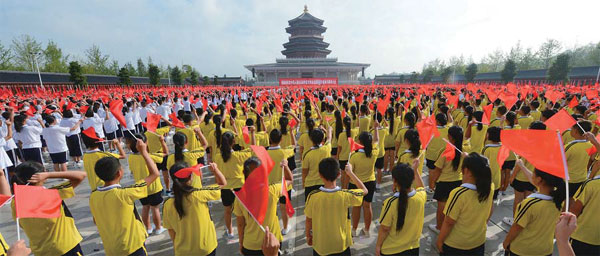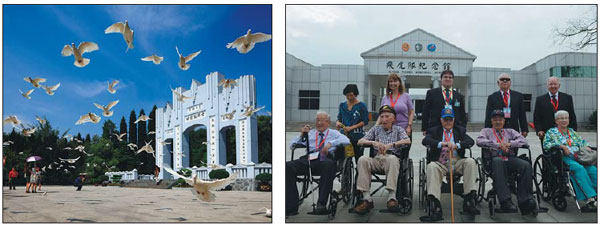Honoring heroes and friends
|
A ceremony was held in front of the Zhijiang Memorial Hall of the Victory over Japan on Sept 3 to commemorate the 70th anniversary of China's victory in Zhijiang, Hunan province. Photos Provided to China Daily |
|
Left: The site where the Japanese surrendered on Aug 21, 1945. Right: Flying Tiger veterans and their families posed for a photo in front of the Flying Tiger Memorial Museum in Zhijiang. |
Home of the legendary 'Flying Tigers' celebrates prominent role in China's wartime struggle
For many people, the Zhijiang Dong autonomous county, Huaihua city, in Central China's Hunan province is famous for its role in China's War of Resistance against Japanese Aggression (1937-45) and World War II.
Located in the west of Hunan, the county is close to the border with Guizhou province, and is a well-known transportation hub. It also acted as an important military base in the fight against the Japanese.
Zhijiang was the home of the American Volunteer Group, or "Flying Tigers"; the legendary squadron of pilots from the United States that helped the Chinese forces fight the occupiers, and made an impressive contribution to the ultimate victory. It was also the first place where representatives of the Japanese Imperial Army signed a document of unconditional surrender to China.
The surrender was signed on Aug 21, 1945, about three weeks before Yasuji Okamura, the commander-in-chief of Japan's China Expeditionary Army, signed the Japanese Instrument of Surrender in Nanjing on Sept 9.
"Japan's surrender in Zhijiang marked the first time in the modern era that Japan was presented as the loser in a war with China," said Wu Jianhong, curator of the county's Memorial Hall of the Victory over Japan.
"It was also the first time since 1937, when Japan started its total war against China, that high-ranking military representatives from the two countries had held a formal meeting," he added.
As a major WWII site, Zhijiang held a series of events to commemorate the 70th anniversary of China's victory, including a ceremony to commemorate the anniversary on Sept 3 and the Fifth China Zhijiang International Peace and Culture Festival on Sept 5, just two days after the V-Day parade in Beijing.
More than 100 guests from home and abroad attended the festival, including Anna Chan Chennault, the widow of the Flying Tiger's leader, General Claire Chennault, a few former members of the squadron and their families.
Former squadron member Paul Crawford is 91 and uses a wheelchair, but his memories of the conflict are undimmed. He said he remembered the whole thing as if it happened yesterday.
"My plane was once shot down by the Japanese and if it were not for the help given by the Chinese people who saved me and my crew, I might not be alive now. The people were really nice and friendly," he said.
When people saluted and called him a hero, Crawford was humility personified. "I'm not a hero. I'm just a man who participated in the war," he said.
The AVG was formed in 1941 under Chennault's command to help China combat Japan's superior air power. All the pilots and ground crew were former members of the US armed forces.
Between August 1941 and July of the following year, they harassed the Japanese from the air, and also helped to train Chinese pilots. In 1942, the AVG became part of the US Army Air Force and was later absorbed into the US 14th Air Force.
Chennault remained in command of the three squadrons and the Chinese took to calling all US airmen "Flying Tigers".
From October 1941 to August 1945, US pilots shot down about 2,600 Japanese planes and destroyed 44 ships. However, they also paid a high price - it's estimated that 2,264 US and more than 900 Chinese pilots lost their lives.
James Whitehead, chairman of the board of the Flying Tiger Historical Organization, praised the help the Chinese people offered their foreign allies. He said about 90 percent of the pilots received help - including a great many who were hidden to avoid capture by the Japanese and were then free to return to their bases and continue the fight.
"It was the cooperation between the two countries that ensured the victory. The special friendship the two countries formed in those days can be a bridge to connect history and the future, and become the foundation of the friendly development of the relationship between China and the US," he said.
To commemorate the pilots' bravery, Zhijiang established China's first Flying Tigers Memorial in 2005. The exhibition features a large number of rare documents, photos and pilots' personal effects.
When Chennault, who had just celebrated her 90th birthday, and other veterans and their families, visited, many were moved to tears as they came upon photos of themselves as young men posing in a familiar environment.
"The whole world is pursuing peace and justice. Those of us gathered here in Zhijiang, just wanted to take the opportunity to remember history and continue to cooperate with each other to maintain world peace," said Chennault on her first visit to China in two decades.
Li Zhaoxing, former minister of Foreign Affairs and president of the China Public Diplomacy Association, was also present. He said the victory commemorations were an opportunity to tell the truth about China's wartime history and deliver the country's message of hope for a peaceful world, including making friends with the new generation in Japan.
Since the first festival was held in 2003, the event has become an important platform for the promotion of international communications and business cooperation.
Meanwhile, Zhijing's fame continues to grow as the home of the Flying Tigers and the place where Japan first surrendered to China.
That fame has also provided the county with a large number of business opportunities. During an economic and trade promotion expo held on Sept 5, agreements were reached on about 15 projects, and contracts were signed worth a total 5.98 billion yuan ($940 million).
hena@chinadaily.com.cn
(China Daily 09/22/2015 page10)
















